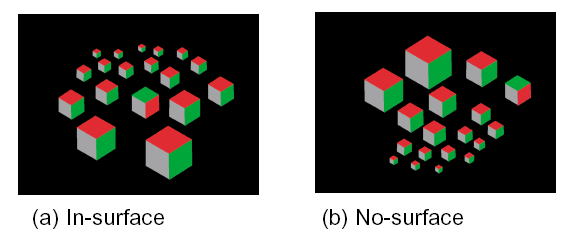
Effects of pictorially-defined surfaces on visual search.
Vision Research, 43 (17), 1869-1877, 2003
Abstract
Three experiments of visual search for a cube (for a square pillar in Experiment 3) with an odd conjunction of orientation of faces and color (a cube with a red top face and a green right face among cubes with a green top face and a red right face, for example) showed that the search is made more efficient by arranging cubes (or square pillars) so that their top faces lie in a horizontal surface defined by pictorial cues. This effect shows the same asymmetry as that of the surface defined by the disparity cue did (McCarley & He, Perception & Psychophysics, 62 (2000) 540), implying that the effect is independent of the three-dimensional cue and the global surface structure influences the control of attention during the search.

Example search displays for the two conditions of Experiment 2. Under the in-surface condition (a), the top faces of cubes form a coherent ground-like surface. Under the no-surface condition (b), where the larger cubes are arranged higher, no coherent surface extending across the faces is perceived. The subject's task was to search for the cube with the odd conjunction of face and color.